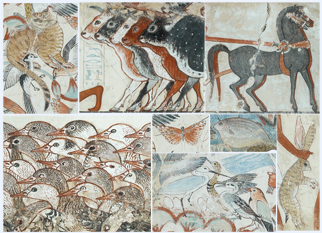8.2 Animals
A second significant discourse that had a particular inflection in English attitudes to art was animal painting. Stubbs is only the most prominent representative of a tradition going back into the seventeenth century, and would continue with redoubled force into the Victorian era, exemplified by a figure such as Landseer.
English art abounds with a veritable zoo of cattle, horses, sheep and birds, not to mention every variety of dog, ranging from the almost scientific studies of Stubbs to Victorian sentimentalism of puppies and kittens.
Many among the most memorable scenes from Nebamun’s tomb-chapel represent animals: the geese, the cattle, the horses, the fish, the rabbits, the birds and butterflies, and of course, Nebamun’s cat (Figure 32). To d’Athanasi one can imagine the tomb-chapel must have seemed like a treasure-trove of potentially very popular animal paintings.

